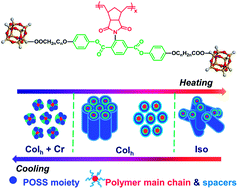Synthesis and sub-10 nm supramolecular self-assembly of a nanohybrid with a polynorbornene main chain and side-chain POSS moieties†
Abstract
A polynorbornene-based mesogen-jacketed liquid crystalline polymer (MJLCP) containing polyhedral oligomeric silsesquioxane (POSS) in the side chain, PNb10POSS, was synthesized through ring-opening metathesis polymerization. The chemical structure of the monomer was confirmed by 1H/13C NMR, high-resolution mass spectrometry, and elemental analysis. Molecular characterizations on the polymer were performed with 1H NMR, gel permeation chromatography, and thermogravimetric analysis. The phase behavior of this new organic–inorganic hybrid polymer was investigated by differential scanning calorimetry, polarized light microscopy, one-dimensional wide-angle X-ray scattering, synchrotron-radiation small-angle X-ray scattering (SAXS), two-dimensional wide-angle X-ray diffraction, and high-resolution transmission electron microscopy. With the competitive self-assemblies of the two covalently connected building blocks, namely MJLCP and POSS moieties, PNb10POSS shows various phase structures including an angstrom POSS crystal (Cr), a hexagonal columnar (Colh) phase and the Cr coexisting, and the Colh phase at different temperatures. The POSS crystal has a tremendous effect on the liquid crystalline (LC) behavior of the MJLCP. The results show that the competition between the crystallization of POSS and the LC formation of the polymer as a whole results in the complex phase behavior of the MJLCP-based nanohybrid. The polymer self-assembles into an organic–inorganic hybrid inclusion complex on the sub-10 nm scale. This work provides a new approach for the design and synthesis of ordered structures constructed by self-assembly on the sub-10 nm scale.


 Please wait while we load your content...
Please wait while we load your content...